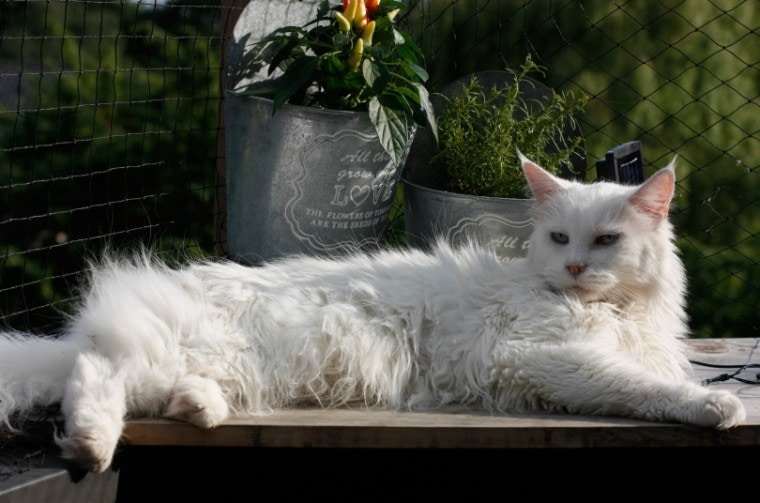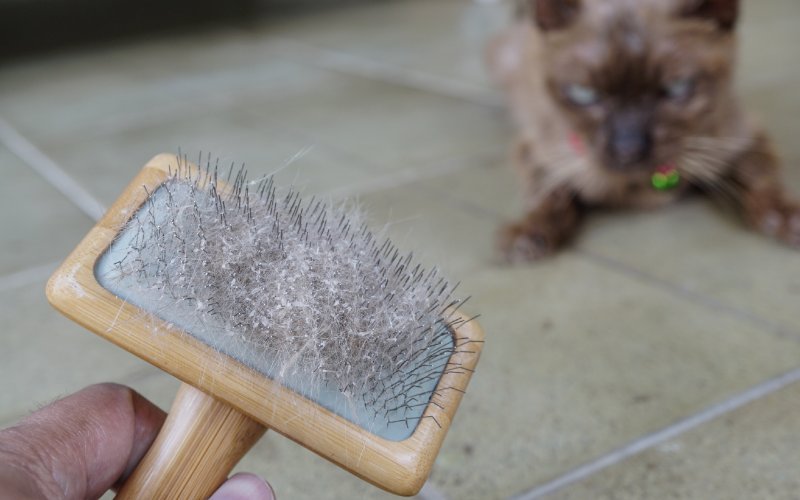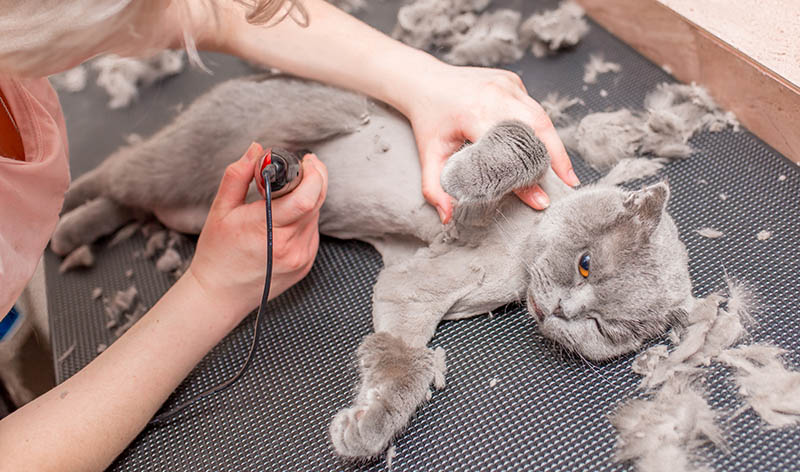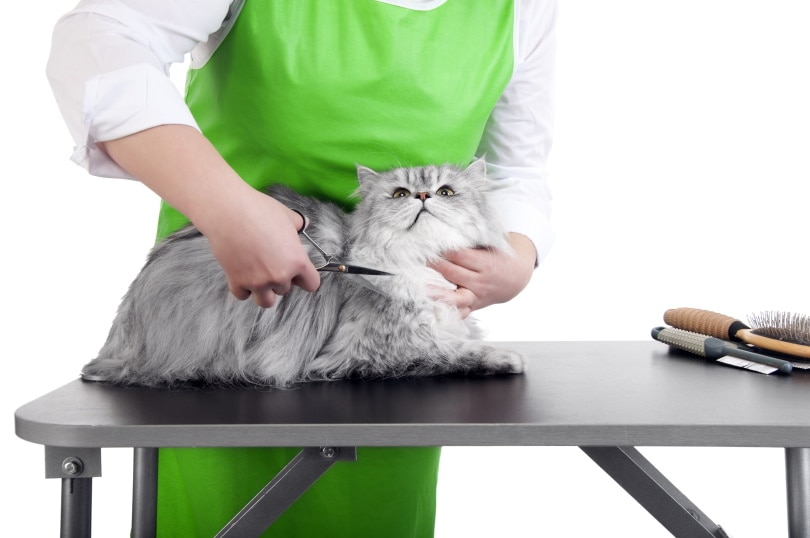
Matted fur is a common problem with longhaired cats, and despite your best efforts, sometimes inevitable. Mats look shabby and they are painful for your cat, constantly pulling on their skin. If left for too long, mats can even lead to infection from your cat’s constant attempts to bite and claw at the knots to try to get them out.
Mats should be removed when they’re first spotted, not just for aesthetic reasons, but because they are painful and can lead to more issues if left unaddressed. In this article, we look at what causes mats, what you should do if you notice mats, and how to prevent them. Let’s get started!
What Is Matted Fur?
Matted fur is a term used to describe very densely clumped fur in a cat’s coat. They are most commonly found in long-haired cats and are usually found in areas that your cat may not be able to easily groom (such as their neck), areas with high amounts of skin movement (such as near their “armpits”), or their rump.
Matted fur can be caused by several factors, which we will discuss shortly; however, of utmost importance is knowing that the condition is painful. Left unchecked, the mats continuously grow as they get even more tangled up. This results in small bald patches on the skin nearby, as the hair gets pulled too far apart from its normal place and into the mat.
Mats often hint at an underlying condition, even in cats that may appear otherwise healthy.

What Causes Matted Fur?
Cats are naturally very fastidious groomers and spend a very large amount of their waking time grooming themselves. Grooming even has social benefits, and cats in a group will frequently groom each other. Likewise, mother cats groom their kittens. Therefore, finding neglected fur that’s become matted should definitely raise some eyebrows. There are several reasons why your cat’s fur ends up matted.
Please note that the list above isn’t comprehensive and just mentions some of the reasons why your cat’s fur might become matted.

Tackling Matted Fur: Before You Start
Please be mindful that once fur is matted, your cat cannot unmat it themselves. Further, mats are painful, especially when they’re pulled at. Even the most docile and friendly cat might suddenly snap at you when you try to remove a mat. If it’s your first time handling matted fur, you should not attempt to fix it yourself and instead look for professional guidance from a groomer or your vet. A vet visit is highly recommended, as uncovering the underlying cause of the mats is crucial to prevent the issue from recurring.
Your cat should be as calm and relaxed as possible before you begin to inspect them for mats.
The 5 Steps to Get Rid of Mats in Cat Fur
1. Brushing
Begin by gently running a brush through your cat’s fur. Try to guide a cat brush gently through the fur. The brush should not snag or pull through any part of your pet’s fur. If it does, there may be a mat present in the area. Keep a very close eye on your cat at this point, as their body language may give you cues about pain. If your cat suddenly pins their ears back, growls at you, takes a swipe, or attempts to escape, they’re likely not comfortable. It is best to not struggle with a cat that’s uncomfortable with being groomed.
Grooming your cat is a process that they either love or hate. If your kitty tends to despise their grooming sessions, you can make it a bit more enjoyable with our favorite brush on the market, the Hepper Cat Brush.
- ONE PUSH RELEASE - This kitten brush / cat brush pops out fur with just a simple press, leaving you...
- DURABLE - Cat shedding can be a tough ordeal. Made of resilient ABS plastic and metal bristles with...
- COMFORTABLE - A cat fur brush with 60 degree angled, fine bristles and rubber stoppers will bring...
With its soft pins and a one-click button for easy clean-up, this brush is something that both you and your cat will enjoy.
At Pet Keen, we’ve admired Hepper for many years and decided to take a controlling ownership interest so that we could benefit from the outstanding designs of this cool cat company!

2. Dematting rake
A specially-made dematting rake may be able to do the trick and rid your cat of loose, new mats. These specialized brushes are made with stainless-steel teeth, with rounded edges to protect your cat’s skin. They can sometimes untangle a mat that’s still not too large or too tightly wound. But some mats are simply too tight for even the dematting rake, and you may need to move on to the next step.
3. Seek Professional Help
If your cat’s matting is just too excessive, it’s best to have a professional groom your cat. As mentioned earlier, a veterinarian’s input is necessary, as they can help ascertain the underlying cause of the matting. In some instances, cats with matted fur are very apprehensive towards being groomed and might require your vet to sedate them.
In addition, mats are very itchy, and your veterinarian will likely prescribe a soothing shampoo or a supplement to help your cat deal with their discomfort.

Only use the next two steps if you’ve been instructed on how to use clippers or grooming scissors by a professional pet groomer or your veterinarian. If you aren’t comfortable with these steps, skip them entirely and have your cat professionally groomed.
4. Clippers
If you’re confident in your grooming skills, you’ll need to use an electric razor, or clippers, to remove the mat. This can be tricky to do, so you’ll need to make sure your cat is calm and, more importantly, you’re able to properly clip them without cutting their skin. If your cat will not sit still or you aren’t confident in your skills, it’s probably best to leave the clipping to a groomer to prevent injury.
Make sure you pull the skin tight and flat to avoid cutting your cat’s skin and try to work as safely as possible. You’ll need to get fairly close to the skin to properly remove the knot, but some knots are very, very close and you’ll need to be extra careful. Also, many electric razors tend to heat up while in use, so be careful not to burn your cat’s sensitive skin.
5. Scissors
Cutting your cat’s mats with scissors is relatively tricky and not advised unless you are experienced in grooming your cat, as you’ll need to be extra careful to not cut your cat’s skin. Make sure you use blunt-nosed scissors to reduce the chance of injury, but even then, your cat needs to be calm and still. Lift the knot as far away from the skin as you can with a fine-toothed comb, and gently cut the hair on the edge of the mat first to loosen it. You can then gradually work your way in and brush out any leftover matting afterward.

Preventing Mats in Cat Fur
Prevention is most certainly better than the cure, and doing your best to make sure your cat doesn’t get mats in the first place will save you a great deal of time and potential stress for your feline. The best way to prevent matting is regular brushing with a proper cat brush. Begin brushing your cat every few days from when they are a kitten to get them accustomed to the process. This will save you time and potential stress in the future.
When grooming your cat, pay close attention to spots they may not be able to easily groom themselves. These include the base of their neck, their underarms, and areas around their rump. If your cat is overweight, obese, or has a condition that limits their mobility, you’ll have to be diligent about helping them keep their fur well kept by grooming them more frequently than you normally would.
You should also consult your veterinarian about the possibility of using supplements to help improve your cat’s fur coat. A healthy coat is less likely to be tangled. Likewise, ensuring you stay on top of parasite preventives and your cat’s routine wellness checkups will help ensure that there aren’t any underlying health issues which could be interfering with your cat’s grooming & coat maintenance.
Conclusion
Preventing mats is far better than trying to get them out, but cats can still get mats and knots occasionally despite their owners’ best efforts. Grooming and brushing your cats regularly will go a long way in helping to prevent their fur from matting. Beginning brushing from kittenhood will make the process much easier.
Removing mats is a relatively complex process and requires the right tools and expertise. Therefore, it is best to consult a professional for your cat’s matting woes. Identifying the underlying cause of your cat’s fur matting will also go a long way in ensuring that the problem does not repeat itself.
You may also want to read:
Featured Image Credit: Piqsels









